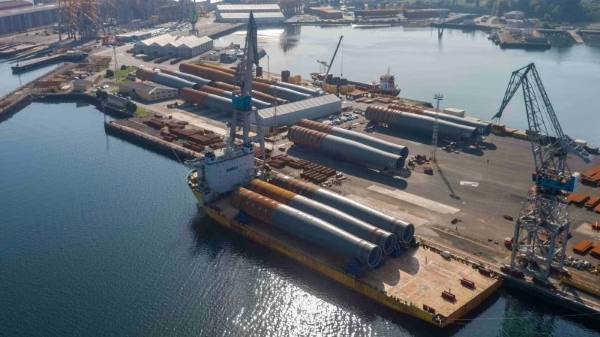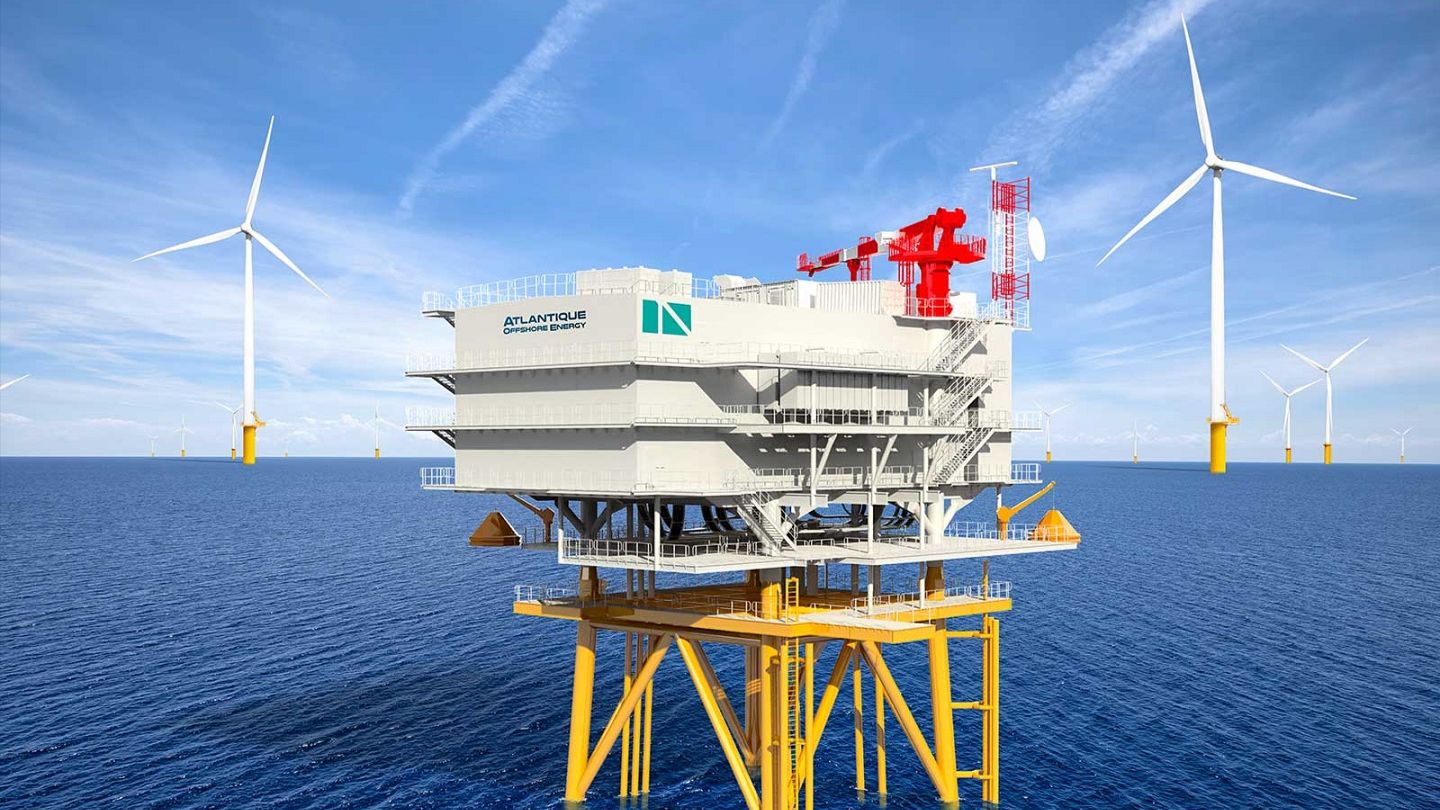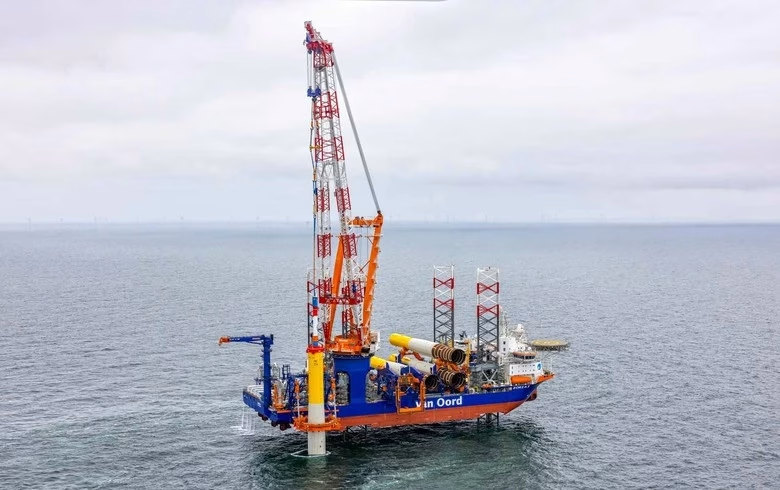Updated November 15th 2025: RWE’s 1.6 GW Nordseecluster offshore wind project has made substantial progress: all 44 monopile foundations plus their secondary steel structures for Phase A were installed by November 2025. These massive monopiles, around 1,500 tonnes each, were transported from Eemshaven, Netherlands, to the site by Van Oord’s heavy-lift vessel Boreas. RWE is using a transition-piece-less design, reducing steel use by installing extended monopiles with secondary steel fitted offshore. The Nordseecluster is being developed jointly with Norges Bank Investment Management, which recently closed on a 49% stake. Substation construction is moving forward, and around 70 km of internal cabling is planned for early 2026. Once fully operational (Phase A by 2027, Phase B by 2029), the wind farm will supply green power to roughly 1.6 million German households.
Published July 30th 2025: The Nordseecluster offshore wind project, led by RWE, reached a major milestone in the construction of the 660 MW Nordseecluster A with the successful installation of its first monopile foundation in July 2025.
Located about 50 kilometers north of Juist Island in the German North Sea, the project continues to advance through phased development, with turbine installation scheduled for 2026 and full commissioning of Phase A expected by early 2027. Together with the planned Nordseecluster B, due by 2029, the project will deliver 1.6 GW of renewable capacity, making it one of the largest offshore wind hubs in Europe.
Van Oord – who also handled RWE’s foundation installation, has also completed installation of the first monopile foundation at Iberdrola’s Windanker offshore wind farm in the German Baltic Sea. The marine contractor is using its heavy-lift vessel, Svanen.
RWE AG Installs First Turbine Foundation at 1.6 GW Nordseecluster Offshore Wind Project
Reported July 30, 2025 – RWE AG, in partnership with Norges Bank Investment Management, has taken a significant step forward in its Nordseecluster offshore wind project by successfully installing the first turbine foundation in the German North Sea.

Located about 50 kilometers north of Juist Island, the massive monopile foundation marks the official launch of offshore construction for Nordseecluster A. Each foundation measures approximately 85 meters in length and weighs 1,500 tonnes, about the weight of 1,000 small cars. Additionally, these steel giants were transported from the Dutch port of Eemshaven aboard Van Oord’s new offshore installation vessel, Boreas, which has the capacity to carry four monopiles at once.
Smart Design Meets Sustainable Strategy
What sets this project apart is its innovative transition-piece-less foundation design. By removing the need for extra steel connectors between monopiles and turbine towers, RWE significantly reduces the amount of steel used, cutting both costs and environmental impact. Secondary features such as boat landings and access platforms will be added offshore. Furthermore, the logistical strategy, including the use of Boreas and the heavy-lift terminal at Eemshaven, has been executed with precision to minimize delays and ensure smooth delivery to the installation site. This approach reflects RWE’s commitment to both efficiency and sustainability.
Also Read 450 MW Neart na Gaoithe (NnG) Offshore Wind Farm Fully Operational, Scotland
A Two-Phase Powerhouse with Massive Capacity
Nordseecluster is being developed in two key phases. Phase one, known as Nordseecluster A, will see 44 Vestas V236-15 MW turbines installed to produce 660 MW of clean energy. These are slated to begin installation in 2026, with full grid connection expected by early 2027. The second phase, Nordseecluster B, will add 60 more turbines delivering an additional 900 MW. Further, this phase is expected to be operational by early 2029. Together, both phases will deliver a staggering 1.6 GW of renewable energy, enough to supply electricity to approximately 1.6 million German homes annually.

More Than Just a Project: A Regional Energy Hub
Nordseecluster is more than a wind farm; it’s a flagship project for Europe’s green energy future. RWE, which holds a 51% stake, oversees all construction and operations, while Norges Bank Investment Management owns the remaining 49%. Impressively, this is RWE’s largest offshore wind undertaking in German waters to date. A fascinating aspect of the Nordseecluster project is its integration of four adjacent offshore zones (NC 1–4), which allows for shared logistics, ports, and infrastructure. This cluster approach not only cuts costs but boosts project speed and coherence. Similarly, RWE’s 100 MW Lafitte Solar project in Louisiana highlights the company’s U.S. renewable expansion, demonstrating how large-scale solar can complement offshore wind in scaling clean-energy generation and regional economic impact. Eemshaven’s Buss Terminal plays a pivotal role, also serving Denmark’s Thor project, making it a strategic hub in the expansion of Europe’s offshore wind sector.
Nordseecluster Offshore Wind Farm Overview
Project Name: Nordseecluster Offshore Wind Project
Developer: RWE AG (51%) and Norges Bank Investment Management (49%)
Location: German North Sea, 50 km north of Juist Island
Total Capacity: Up to 1.6 GW
Phases: Two phases; Nordseecluster A (660 MW) and B (900 MW)
Turbines Used: Vestas V236-15 MW offshore wind turbines
Operational Dates: Phase A operational by early 2027; Phase B by early 2029
Foundation Design: Transition-piece-less monopiles to reduce steel usage
Energy Output: Enough to power approx. 1.6 million German homes
Interesting Fact: Combines four offshore sites (NC 1–4) for greater efficiency and shared infrastructure
Nordseecluster Offshore Wind Project Timeline
Pre-2024: RWE advances planning, permitting, and environmental studies for the Nordseecluster sites
July 2023: Offshore grid connection secured by TenneT. German authorities also confirm inclusion in federal offshore development plan
2024: Final investment decision (FID) and procurement agreements completed
July 2025: Offshore construction begins with the installation of the first monopile foundation for Nordseecluster A
2026: Turbine installation for Nordseecluster A scheduled to begin
Early 2027: Commercial operation of Nordseecluster A (660 MW)
2027-2028: Construction activities for Nordseecluster B to start, including foundation and turbine installation
2029: Full commissioning of Nordseecluster B (900 MW), bringing the total project capacity to 1.6 GW

